Musicarta Modes - Mediant Substitution
Mediant Substitution (Part 4)
This Module applies the mediant substitution technique to the Aeolian four-chord set in D Aeolian minor.
Download up-to-date MIDI files for this page.
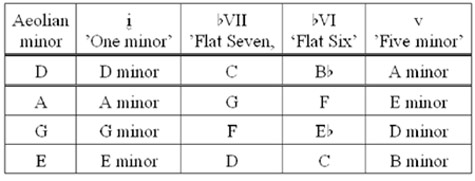
In D Aeolian minor, the chords are D minor, C, B flat and A minor. The other sets of chords in the table above are there to help you use the Roman numeral system to understand and transpose groups of chords.
Here are all the inversions of the module chords shown on keyboards. Run through them using any broken chord pattern of your choosing.
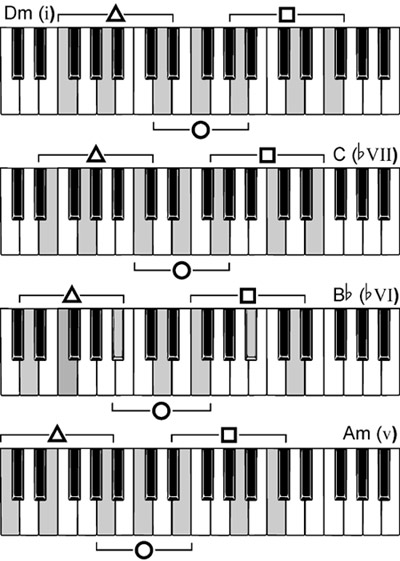
Here’s a riff on these four chords with no mediant substitution at all.
This is the chord sequence.

The right hand chords are shown as triads with inversion symbols. Find them using the keyboard diagrams.
Here is an MS sketch of the riff with the broken chord BMT analysis.

Look out for the anticipation. All the C-for-chords in the BMT analysis are the next chord, anticipated (pulled forward a quaver).
The right hand strays a long way down into the between-the-staves leger lines. Here is the right hand written an octave higher but with the 8vb (play an octave lower) sign. Use it if it helps.
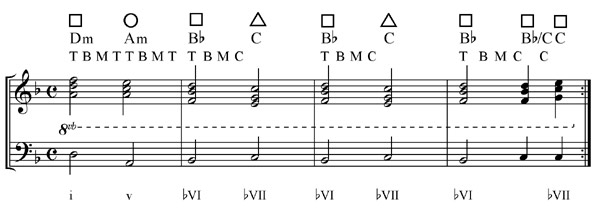
When you can find the chords without any
trouble, study the BMT analysis as you listen, and copy the riff audio. Here it is
again.
The riff with mediant substitution
Now start treating some of the chords with mediant substitution. You drop the bass note a third down the D Aeolian minor scale from the root of the chord. Here’s a quick reference table.

Here’s one possibility.

Errata: the C chord in bar 3 is not substituted. Read plain 'c'.
The right hand chords are still shown as triads with inversion symbols and the mediant substitution seventh chords are shown as slash chords. (There is one slash chord – Bë/C in the last bar – which is not a mediant substitution chord.)
Here is a practice-speed audio performance of the chords (top) and a possible performance (bottom).
Errata: the C chord in bar 3 of the 'plain chords' audio is not substituted.
Except for the last half-bar, all the chords in the second half have been substituted (the root has been lowered a third).
Now apply mediant substitution everywhere you can.

Here is the ‘skeleton chord’ performance (top), plus a gentle broken-chord ‘realisation’ of the sequence (below).
Remind yourself of the mediant substitution process.
Your right hand triads stay the same but…
…you lower the root a third to make mediant substitution seventh chords.
The best-sounding chord sequences are a mix of the original chords, some mediant substitution chords and some ‘reverse mediant substitution’ chords – explained in the following section.
Reverse mediant substitution
Mediant substitution works because chords a third apart share two chord tones (and the other chord tone creates an interesting seventh chord.)

Mediant substitution works both ways. You can either lower the root a third to get a seventh chord on the new root (ordinary mediant substitution), or raise the whole triad a third to get a seventh chord on the existing root (reverse mediant substitution).
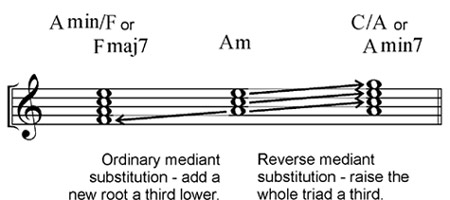
The only usable new chord reverse substitution gives when applied to our four chords is D minor 7 (see below), but reverse substitution lets us use our existing mediant substitution seventh chords in more places – as discussed in the following section.

Alternative mediant substitution chord harmonies
Mediant substitution shows us that we can use any of the chords in the following table under the riff’s four top notes. (Proper spellings for the mediant substitution seventh chords are given in brackets.)

Here are some sample chord sequences using chords from the table above. From now on, proper spellings for the mediant substitution seventh chords are used, and the ‘slash chord’ spellings are in brackets.
Sequence One

Sequence Two

Sequence Three

Sequence Four

Putting together your own chord sequence
When you can substitute chords like this – potentially three for every melody note – you have multiple choices. Lining up all the chord sequences for the Module 17 riff vertically (below), you can in theory jump to any chord in the next column.
Here’s what putting together a chord sequence from all the options might look like on paper.
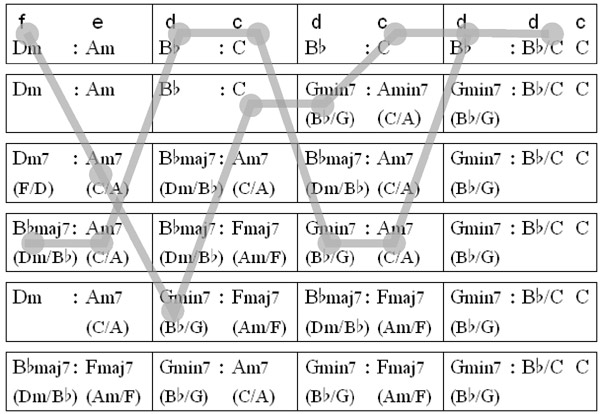
The first chord sequence – the original – has the top notes of the right hand chords above the chord symbols, to remind you. Proper spellings for the mediant substitution seventh chords are used, but the ‘slash chord’ spellings are given in brackets to help you construct the chords on the fly.
Play the two chord sequences indicated. Here are audios of just the simple chords – make a performance in the style of the module. The sequence starting on D minor comes first.
|
|
|
Try out the possible mediant substitution basses and write down the versions you like most in the table in your workbook.
|
OUT NOW! |
THE MUSICARTA BEAT & RHYTHM WORKBOOK At last! An effective approach to keyboard rhythm & syncopation skills. Learn more! |
ONLY $24.95! |
MODES |
The MusicartaA methodical approach to keyboard syncopation for
|
PUBLICATIONS
exciting keyboard
creativity courses
CHORDS 101
WORKBOOK

~HANON~
video course

Musicarta
Patreon
PENTATONICS
WORKBOOK
video course

Creative Keyboard
video course

BEAT AND RHYTHM
WORKBOOK

- Volume 1 -

12-BAR PIANO
STYLES WORKBOOK

MUSICARTA MODES
WORKBOOK

PIANO STYLE

CANON PROJECT
video course

VARIATIONS
video course


- Piano Solo -
video course

- Piano Solo -


YouTube playlists





 THE LOGO
THE LOGO
